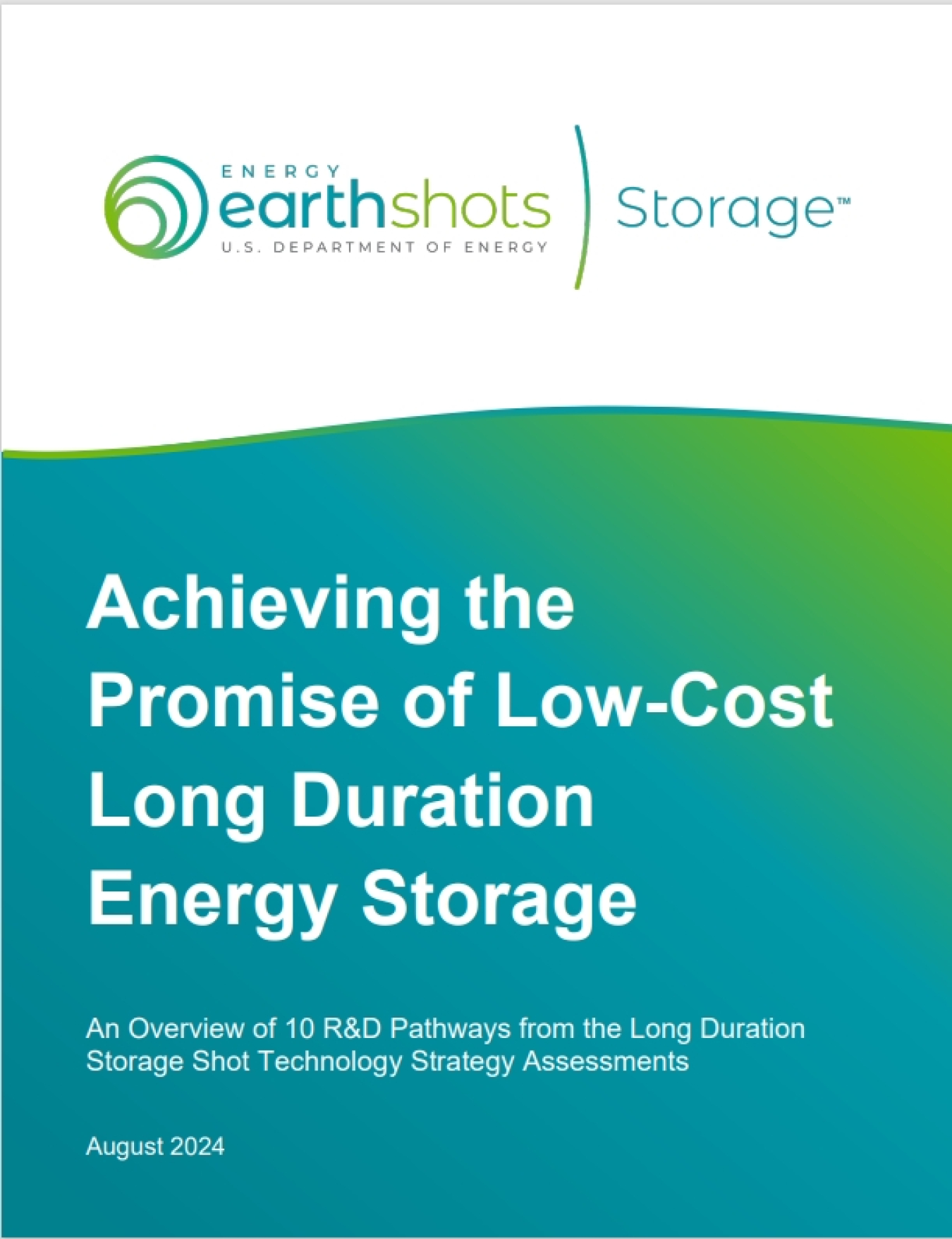Promotion of a new report on Long Duration Energy Storage called Achieving the Promise of Low Cost Long Duration Energy Storage.
August 6, 2024
By Ben Shrager & Nyla Khan
How can innovation drive down the cost of emerging long duration energy storage technologies? Learn the answer to this question and more in the latest report by DOE’s Office of Electricity (OE) called, "Achieving the Promise of Low Cost Long Duration Energy storage,” part of the Office’s efforts to support the Long Duration Storage Shot.
In this document, OE charts a path to understanding the time and investments to implement profound change in our energy landscape. The report highlights and synthesizes the findings of the 2023 Long Duration Storage Shot Technology Strategy Assessments (links to Storage Innovations 2030 | Department of Energy), which identify pathways to achieve the Storage Shot ($0.05/kWh levelized cost of storage) for 10 promising long duration energy storage (LDES) technologies.
This report is one example of OE’s pioneering R&D work to partner with our electric industry partners to prepare our nation’s grid for future demands. OE cultivated partnerships with hundreds of diverse members of the energy storage ecosystem—including energy storage developers, manufacturers, national laboratory researchers, experts from higher education institutions, and other key stakeholders—to analyze and champion promising emergent energy storage technologies.
The report describes 10 Long Duration Energy Storage (LDES) technologies that span four storage technology families:
- Electrochemical energy storage: flow batteries, lead-acid batteries, lithium-ion batteries, sodium batteries, supercapacitors, and zinc batteries
- Chemical energy storage: bidirectional hydrogen storage
- Mechanical energy storage: compressed-air energy storage and pumped storage hydropower
- Thermal energy storage: molten salt systems and other thermal storage technologies
See the table below for a preview of the report’s content. This table is included in the report to highlight the specific LDES technologies and the potential innovations that could drive down costs.
Table 1. Top 3 potential innovations to drive down the 2030 levelized cost of Long Duration Energy Storage technologies. Where indicated, innovations address specific storage technologies in each technology family.
| Family & Technology | Description | Top 3 Potential Innovations | |
| ELECTROCHEMICAL |
Flow Batteries (FBs) | Pump negative and positive electrolytes through energized electrodes |
|
Lead-acid Batteries (PbAs) | Use a lead dioxide positive electrode and metallic lead negative electrode |
| |
Lithium-ion Batteries (LIBs) |
Include lithium in the active materials in the positive electrode |
| |
Sodium-ion Batteries (NaIBs) | Include sodium in the active materials; this analysis also considers other sodium battery varieties |
| |
| Electrochemical Double Layer Capacitor (EDLC) Supercapacitors | Accumulate electric charge on porous electrodes filled with an electrolyte; this analysis also considers other supercapacitors |
| |
Zinc (Zn) Batteries |
Include zinc in the active materials in the negative electrode |
| |
| CHEMICAL |
Hydrogen Storage | Produces hydrogen through electrolysis in above ground tanks/below ground caverns |
|
| MECHANICAL | Compressed Air Energy Storage (CAES) | Stores electric energy in the form of potential energy through compressed air |
|
Pumped Storage Hydropower (PSH) | Pumps water from a lower reservoir to an upper reservoir to store energy |
| |
| THERMAL | Molten Salt Thermal Energy Storage (TES) | Stores energy with heat as an input or output; this analysis also considers other TES varieties |
|
These identified innovations show incredible promise to achieve the Long Duration Energy Shot cost goals. By summarizing the Storage Innovations’ specific and quantifiable research, development, and deployment (RD&D) pathways to achieve the Storage Shot goals, this report is a useful tool to analyze the most impactful combinations of innovations that drive down the cost.
The Storage Innovations 2030 Strategy Assessments determined that on average, the top 10% of innovation portfolios can reduce costs by 12%–85% to $0.03/kWh–$0.26/kWh across LDES technologies. The average cost of implementing innovations ranges roughly from $100 million–$1 billion and would take 6–11 years. For the full suite of innovations and full reports on the results for each LDES technology area, see the Technology Strategy Assessments.
This is the most exciting time to be in energy storage since the industry’s inception. There is a unique opportunity now to ensure that every American home and business has access to reliable, resilient, secure, and affordable energy, and that the U.S. sustains its global leadership in the clean energy transformation.
Read the report.

